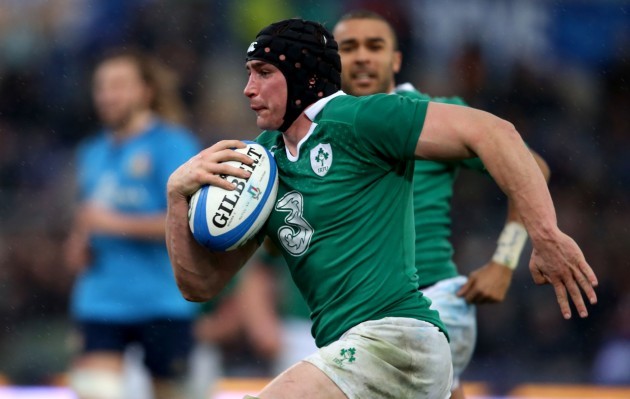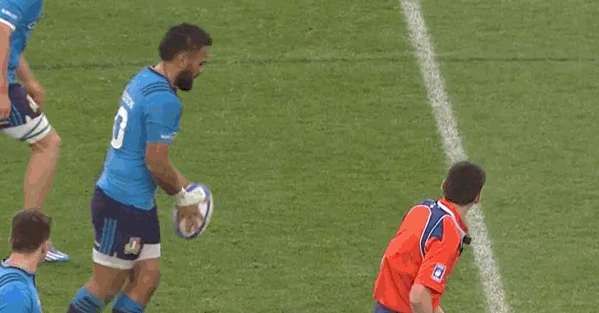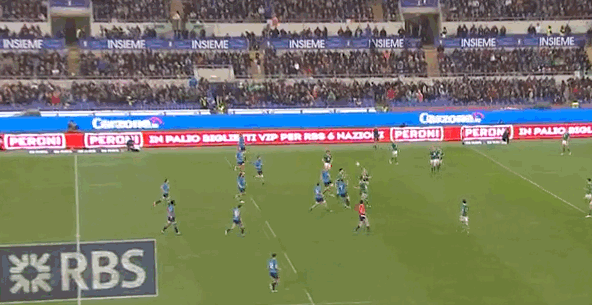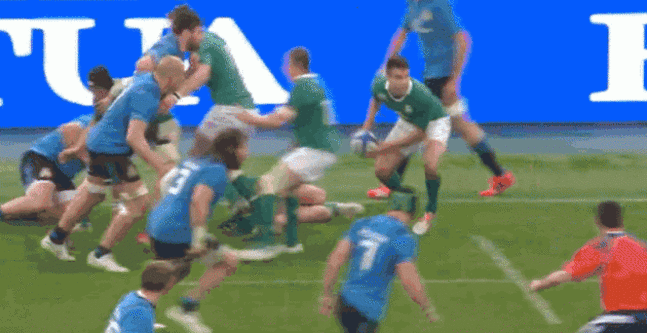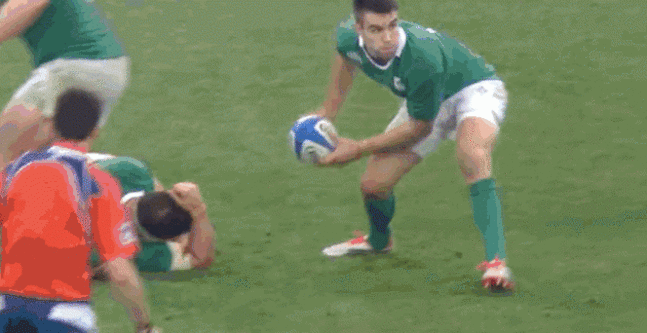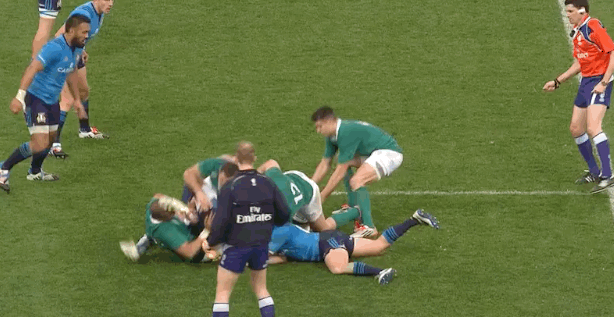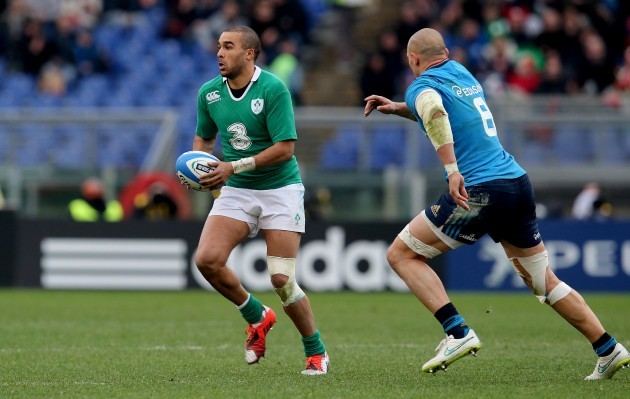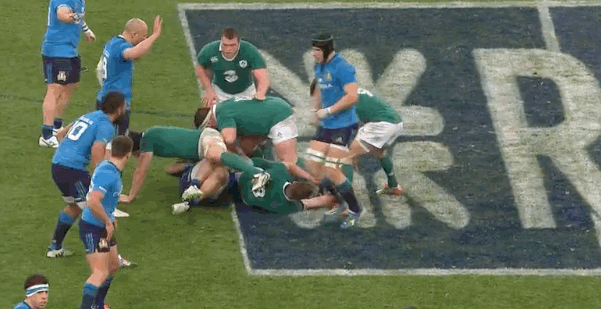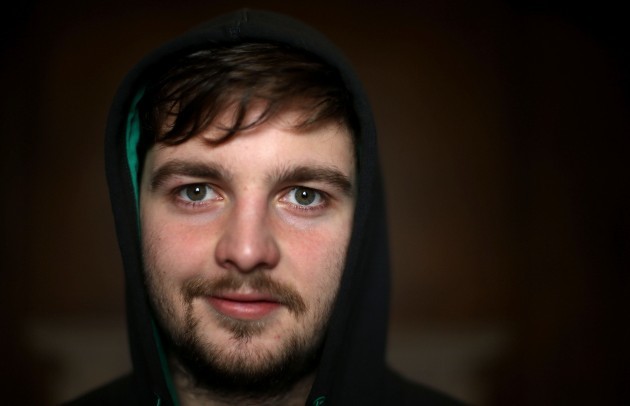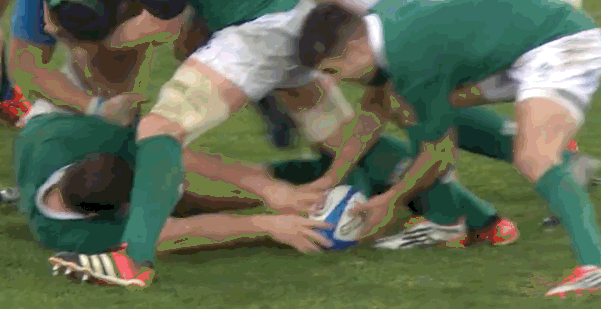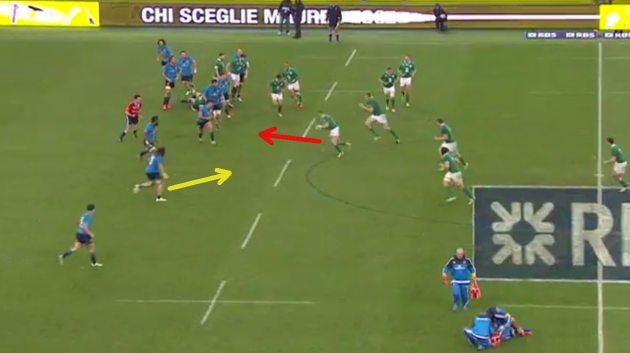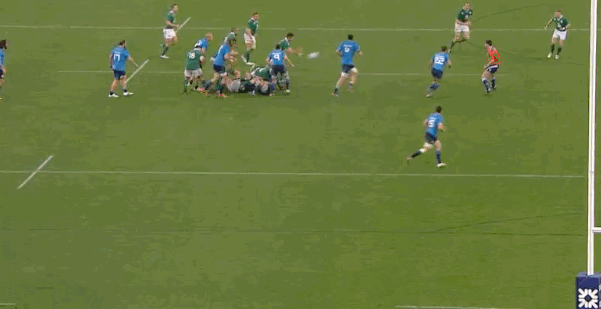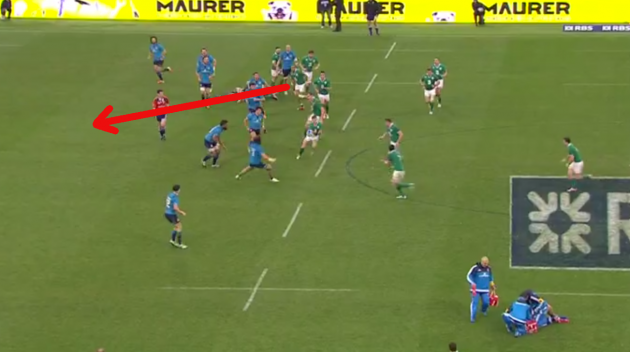AS WE INDICATED earlier in a piece on Conor Murray’s try against Italy, it’s our intention here at The42 to dissect each of Ireland’s tries in this year’s Six Nations as a means of taking stock of how, why and when Joe Schmidt’s team are scoring.
Here, we turn to the second of the brace Ireland managed in Rome on Saturday afternoon. Tommy O’Donnell’s try came swiftly after the Murray effort, the game already having been essentially decided and with Italy’s defensive effort easing.
The Munster openside flanker has deservedly picked up plenty of the plaudits for the try, but there were many other actions that went into the attacking passage, some of which we examine here.
In great contrast to the Murray try, which took upwards of five minutes of build-up to come about, there was just 1 minute and 11 seconds between Kelly Haimona’s restart and O’Donnell diving over just to the left of the posts in this instance.
Over nine phases, Joe Schmidt’s side did something they hadn’t really attempted to do up until then – attack with the ball in hand from inside their own half.
There had been fleeting instances of running from deep beforehand, largely after receiving kicks, but it was only in the 66th minute that we saw Ireland unleash their attacking potential from a long way out.
Italy were down to 14 men at this stage, Leonardo Ghiraldini having been sin binned in the lead-up to Murray’s try, and there were real echoes of Dublin last year, when Ireland wore the Italians down over 60 minutes before scoring four tries in the last quarter.
That’s no justification for not scoring until this late stage in Rome at the weekend – Ireland had opportunities earlier in this game, but a lack of penetration and ruthlessness, as well as the Italian defensive effort, meant Schmidt’s men had to be patient.
We’ll look at that facet of the game elsewhere, but for now we focus on the composition of the O’Donnell try.
Access point
Actually securing the restart from Haimona is where the score begins, and an area in which Ireland had at least two failings in the game.
Losing the restart after Ian Keatley had kicked Ireland 9-0 ahead in the 36th minute was particularly costly, sparking as it did an attacking passage from the home side that ended with Haimona kicking a penalty on the stroke of half time for a 9-3 scoreline.
Italy, to give them their dues, are a good restart side, but Schmidt will point to the shortcomings in this area as unacceptable. Ahead of the O’Donnell try, however, Ireland did manage to get it right.
Initially, replacement lock Iain Henderson looks in position to gather the ball, but as it glides over the Ulsterman, Paul O’Connell gives the call from behind and catches, benefiting from a small bit of shielding from Henderson and Jordi Murphy.
From this position earlier in the game, Ireland might have tested the Italian defence with two or three phases, set themselves up to kick the ball and then launched a contestable garryowen or box kick, competing hard in the air to regather or at least pressurise.
Instead, the Six Nations holders being this attack by moving the ball to the touchline with a nice loop play.
One thing to take note of here is O’Donnell as the ball is gathered by O’Connell from the restart. The Munster openside is immediately looking back over his shoulder to account for which of his teammates are nearby.
He sees Sean Cronin and indicates to the hooker to move inside him and run the loop play with Murray. As we pointed out in the piece on Murray’s try, Ireland’s players know their ‘roles’ down to a tee.
In this case, Cronin is one of the players tasked with running this type of play, probably because of his strong handling and burst of acceleration as a potential carrier if space opens in front of him.
Positively, the ball finds its way to Tommy Bowe with a screen pass behind O’Donnell and the right wing is given a chance to run at a defender one-on-one. That was something of a rarity in this game, both Bowe having only six carries despite Ireland’s hefty share of more than 60% of the possession.
Over the gainline
While their numerical advantage is useful, the element of invention here helps Ireland over the gain line and results in Italy being on the back foot immediately. That gain line progress makes every action that follows a little bit easier for Ireland.
Case in point is Marty Moore’s carry on the very next phase. The Leinster tighthead arrives onto a short pass from Murray from depth and at pace to drive further up the pitch again.
From an individual point of view, Moore’s pre-contact footwork here is very pleasing for the Irish coaching team. The 23-year-old is moving at speed, but still manages a step off his left foot before straightening back up immediately.
That movement takes him through the attempted tackle of Martin Castrogiovanni and, with 14-man Italy committing no one to the post-tackle zone, means there’s basically no ruck for Ireland to win.
This is one of the big advantages Moore has over Mike Ross, his mobility and agility. It means he’s a stronger carrier, but also allows him to shift around in defence with greater ease.
Ross had a strong scrummaging performance against Italy having recently lost his place at Leinster to Moore, so it leaves Schmidt, Simon Easterby and Greg Feek with a welcome selection debate for the French game.
The result of Moore’s footwork here is lightning fast ball for Murray. Again, Ireland look to a loop play to shift the ball all the way to the opposite side of the pitch.
Paulie can play ball
As with the ball finding its way to Bowe on the right wing just moments earlier, it’s hugely encouraging to see Paul O’Connell handling the ball in the manner above.
Ireland’s game plans don’t generally call for a huge amount of passing from forwards, but O’Connell made six against the Italians. It’s something that could well be used more if Schmidt looks for his side to be more adventurous in attack.
This return pass to Madigan is a simple one, but it’s probably more difficult to pull off effectively than it looks. O’Connell does a fine job of running a line back against the grain, eyeballing the defence and forcing Tommasso Allan to briefly sit down.
The fact that Allan hesitates here, sticking on O’Connell for a spilt second gives Ireland’s backs more time on the ball on the outside edge. It’s a nice involvement for the captain beyond his usual workhorse duties.
Jared Payne batters into contact out on the left to end the phase, with Simon Zebo and Rob Kearney hitting the ruck. Ireland are perhaps fortunate that Kearney was not pinged for coming in from the side here to clear out Leonardo Sarto, but referee Pascal Gaüzère is content and the fullback helps to ensure Ireland retain possession.
Murray gets the ball away under pressure from Kelly Haimona at the ruck, the Munster scrum-half maintaing his composure to accurately find O’Connell despite the pressure from Italy’s 10.
O’Connell is the man who volunteers himself for the short carry – which echoes the pattern we saw with Moore following up out on the right – and there’s a clever little moment of on-ground skill from the veteran lock here too.
The Ireland captain hits the ground after Marco Barbini makes a low tackle and there is an immediate turnover threat from Allan [wearing 22]. O’Connell buys Ireland a split second with a commando roll on the ground, ensuring Allan can’t clearly clamp onto the ball.
It’s a tiny thing, but it allows Toner and O’Donnell enough time to arrive in and clear Allan away from the pill, again ensuring Murray has quick possession to play with.
Feeding the Llama
Madigan has a sharp dart on the next phase of Ireland’s attack, carrying the ball into contact and leaving Ireland without their recognised first receiver.
As on other occasions during this fixture, it’s left wing Zebo who steps into position and provides Murray with an outlet. This was one of the major positives in the Ireland attack at Stadio Olimpico, with Zebo at least thrice acting as first receiver.
Earlier in the second half, a beautiful right-handed pass had released Payne down the left wing for a canter, while shortly before that Zebo had turned on a clever goose step to draw in two defenders and allow Ireland to make progress down that same touchline.
Moving forward, it’s something we’d love to see more of from Ireland. In an international rugby world of defensive organisation and sheer directness with ball in hand, Zebo adds an important element of the unpredictable.
In this instance, Zebo does the simple thing, receiving the ball from Murray, getting his head up to see Josh Furno [Italy 5] offering the slightest of dog legs in the defensive line, and shifting the ball into Henderson’s hands.
When you’ve got a man of Henderson’s dynamism, it makes sense to get the ball into his hands early in a situation like this, allowing him to take the defender on one-on-one and get that big fend of his working.
Henderson – known as ‘Llama’ by his teammates – only had two opportunities to carry the ball in his 15-minute cameo against Italy, but made sure he eked every last inch out of them.
Here, he shifts the ball into his right hand intelligently, opening up his left to fend Furno off, showing real power to do so. He twists and spins, driving his legs hard all the time to eat up the yards for Ireland.
That leg drive is a big factor, and not something to underestimate. Henderson’s power is a real bonus for Ireland off the bench, while he also chipped in with a tackle late on against the Italians.
There appear to be strong calls for the Ulsterman to start, but Devin Toner delivered his best performance for some time in Rome and remains vital to the lineout, scrum and restarts, while his rucking work is usually of good quality.
Henderson may have to wait for his starting chance, but his explosiveness off the bench could be decisive for Ireland in this championship, as it was for this try in Stadio Olimpico.
Picking out the fatties
Jack McGrath makes a short carry just to the left of the ruck after Henderson is eventually hauled down, with Moore arriving for a nice, effective clear out and O’Connell removing another Italian defender.
Italy are on the ropes at this stage, nine phases into the Ireland attack and having been shifted from one touchline to the other, while retreating a good 20 metres up the pitch. It’s an ideal opportunity for someone like Madigan to get on the ball and do the playmaking for which he is so renowned.
That’s exactly what happens as the Leinster man fires a superbly-weighted pass to O’Donnell to send the Munster back row galloping into a hole in the Italian defence and on to the tryline.
At this point in the game, Castrogiovanni is the only starting front row, aside from the much fitter Jack McGrath, who is left on the pitch [both players were subbed off within a minute or so of Madigan's conversion of the try].
When he makes the defensive error above, Castrogiovanni has already been through 66 minutes of play, making 15 tackles and working hard at the set-piece. That’s a tough auld shift for a 33-year-old and makes him precisely the man you’d want to be running at at this stage of the game.
As Madigan receives the ball, he takes a swift, sharp step back in towards the ruck [red arrow above] and that helps to draw Castrogiovanni further inwards, completely out of sync with the rest of Italy’s defensive line and opening a huge hole on his outside shoulder.
Again, it’s a little detail from Madigan, but it adds up to helping O’Donnell sprint through the gap. The line from the Munster flanker is ideal after he glances up and spots the space, reaching out to demand the ball from Madigan.
The pass is really well weighted and it’s notable that it’s an end-over-end, rugby-league style release. The temptation here is to absolutely rip a spinning pass at O’Donnell to get the ball to the space quicker, but far more suitable is this more understanding approach.
Just prior to the start of this phase, there was also clear evidence of Madigan organising Murphy and O’Donnell into shape outside him, exactly the kind of calling and authority Schmidt wants from his out-halves.
The finish from O’Donnell is superb, as he runs through a flimsy tackle attempt from the out-of-form Andrea Masi and then gets a strong left-handed fend in on Luca Morisi as the Italian defender attempts to rescue.
Equally as impressive is the pace to finish the try off, something we haven’t seen from O’Donnell in Ireland colours too often. It’s rare that a flanker gets to stretch the legs in this manner, but it underlines O’Donnell’s physical prowess.
On cap number seven, and in his first Six Nations start, O’Donnell had a strong outing, particularly in defence. The Tipperary man’s tackle count of 13 was second only to Robbie Henshaw’s 15, while there was quality along with the quantity too.
With Sean O’Brien now in doubt for the clash with France on Saturday in Dublin, O’Donnell will feel he’s put his best foot forward to retain Ireland’s seven shirt if the Tullow Tank is not called upon.
Should Jamie Heaslip return to the starting XV, there is temptation for Schmidt to shift Jordi Murphy to the seven shirt too, possibly meaning another welcome selection conundrum for the Irish coaching staff.
Before we finish, it’s worth just pointing out a final detail on the O’Donnell try. As the openside finishes, he has strong support either side from Zebo and Henshaw, with Jordi Murphy following in behind.
The Connacht centre has worked hard from the outside to get near O’Donnell’s wake, while Zebo has tracked all the way across from the other side of the pitch on a line that is now becoming commonplace in his game.
Go back to the first GIF of the O’Donnell try and look out for Zebo running a really positive support line from close to the ruck just after Murray moves the ball away.
Zebo has been running this sort of line all season for Munster and Ireland, despite not getting the ball more often than not. He’s anticipating play far more intuitively and actively, and it’s something Schmidt pushes hard as a coach.
O’Donnell doesn’t need his Munster teammate’s support this time, nor the presence of Henshaw outside him, but these are the little things that don’t go unnoticed by the Kiwi head coach.
If O’Donnell had been hauled down from behind, Zebo was present for the offload or to hit the ruck. It’s easy not to run this line, and it would be unlikely the majority of us would have bemoaned his absence if he hadn’t.
Schmidt sees it all though, and these involvements even off the ball can be key when it comes down to selecting his team.
